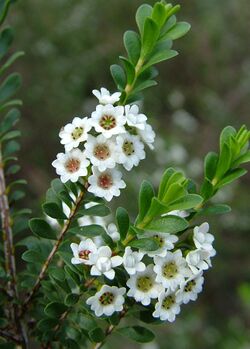Biology:Thryptomene calycina
| Grampians thryptomene | |
|---|---|

| |
| Thryptomene calycina, the Grampians, Victoria | |
| Scientific classification | |
| Kingdom: | Plantae |
| Clade: | Tracheophytes |
| Clade: | Angiosperms |
| Clade: | Eudicots |
| Clade: | Rosids |
| Order: | Myrtales |
| Family: | Myrtaceae |
| Genus: | Thryptomene |
| Species: | T. calycina
|
| Binomial name | |
| Thryptomene calycina (Lindl.) Stapf[1]
| |
| Synonyms[1] | |
| |
Thryptomene calycina, commonly known as Grampians thryptomene,[2] is a species of flowering plant in the family Myrtaceae and is endemic to Victoria in Australia. It is an erect or spreading shrub with oblong, elliptic or egg-shaped leaves with the narrower end toward the base, and white flowers with five stamens.
Description
Thryptomene calycina is an erect or spreading shrub that typically grows to a height of 1–3 m (3 ft 3 in–9 ft 10 in). Its leaves are oblong to elliptic or egg-shaped with the narrower end toward the base, 5–14 mm (0.20–0.55 in) long, 2–4 mm (0.079–0.157 in) wide and sessile with a keel on the lower surface. The flowers are borne singly, in pairs or groups of three in upper leaf axils on a pedicel 2–6 mm (0.079–0.236 in) long. The flowers are often pinkish in bud, the sepals and petals similar to each other, white, broadly elliptic, about 1.5 mm (0.059 in) long and there are five stamens. Flowering mostly occurs from July to November.[2][3][4][5]
Taxonomy
This species was first formally described in 1838 by John Lindley who gave it the name Baeckea calycina in Thomas Mitchell's book, Three Expeditions into the interior of Eastern Australia .[6] In 1924, Otto Stapf changed the name to Thryptomene calycina in The Botanical Magazine.[7]
Distribution and habitat
Grampians thryptomene mostly grows in sandy soil and is found in heath and heathy woodland in the Grampians, although it is naturalised in a suburb of Melbourne and there is an old record from South Australia.[2]
Conservation status
This thryptomene is listed as "rare in Victoria" on the Department of Sustainability and Environment's Advisory List of Rare Or Threatened Plants In Victoria.[8]
Use in horticulture
Thryptomene calycina is propagated from cuttings and is sometimes available in commercial nurseries. It requires light soil and full sun or part shade.[5]
References
- ↑ 1.0 1.1 "Thryptomene calycina". Australian Plant Census. https://biodiversity.org.au/nsl/services/apc-format/display/77349.
- ↑ 2.0 2.1 2.2 Jeanes, Jeff A.. "Thryptomene calycina". Royal Botanic Gardens Victoria. https://vicflora.rbg.vic.gov.au/flora/taxon/f1e05cd3-8118-4e30-892f-b896a0b88c00.
- ↑ "Thryptomene calycina". State Herbarium of South Australia. http://www.flora.sa.gov.au/cgi-bin/speciesfacts_display.cgi?form=speciesfacts&name=Thryptomene_calycina.
- ↑ Wild Plants of Victoria (database). Viridans Biological Databases & Department of Sustainability and Environment. 2009.
- ↑ 5.0 5.1 Beeton, Irene. "Thryptomene calycina". Australian National Botanic Gardens. https://www.anbg.gov.au/gnp/gnp1/thryptomene-calycina.html.
- ↑ "Baeckea calycina". APNI. https://id.biodiversity.org.au/instance/apni/532627. Retrieved 12 May 2021.
- ↑ "Thryptomene calycina". APNI. https://id.biodiversity.org.au/instance/apni/491367. Retrieved 12 May 2021.
- ↑ "Advisory list of rare or threatened plants in Victoria - 2014". The State of Victoria Department of Environment and Primary Industries 2014. https://www.environment.vic.gov.au/__data/assets/pdf_file/0021/50448/Advisory-List-of-Rare-or-Threatened-Plants-in-Victoria-2014.pdf.
Wikidata ☰ Q7798625 entry
 |

